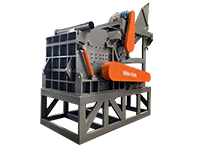Single-shaft shredders have emerged as indispensable equipment in modern industrial waste processing, renowned for their versatility, cost-effectiveness, and reliable performance. This guide dives into the essential details of single-shaft shredders, covering their operational essentials, selection criteria, maintenance practices, and real-world applications, tailored for industry professionals and buyers seeking actionable insights.
I. Core Working Principles and Operational Features
1. Fundamental Shredding Mechanism
A single-shaft shredder operates on a shear-tear principle, driven by a rotating main shaft fitted with helically arranged moving cutters. These cutters interact with fixed blades on the machine housing to progressively break down materials. The involute-shaped cutter design ensures "pre-compression before cutting," minimizing energy loss and reducing cutter abrasion—critical for handling high-toughness materials.
2. Key Operational Advantages
• Energy Efficiency: Consumes 30% less power than dual-shaft shredders under the same throughput, thanks to optimized torque distribution.
• Material Versatility: Excels at processing flexible and tough materials like plastic films, woven bags, textile fibers, and light-gauge metals.
• Uniform Output: Adjustable cutter gaps (typically 5-50mm) allow precise control over particle size, ideal for downstream recycling or reprocessing.
• Self-Cleaning Performance: Spiral cutter arrangement prevents material tangling, reducing downtime for manual cleaning.
II. Critical Selection Parameters
1. Core Specifications Overview
| Parameter | Small (Φ400) | Medium (Φ800) | Large (Φ1200) |
| Throughput | 50-150kg/h | 300-800kg/h | 1000-2000kg/h |
| Main Shaft Power | 30-50HP | 100-180HP | 225-430HP |
| Cutter Material | 42CrMo | Wear-resistant alloy (58-62 HRC) | Imported carbide alloy |
| Maximum Feed Size | ≤300mm | ≤600mm | ≤1000mm |
| Typical Applications | Laboratory/small-scale recycling | Medium-sized production lines | Large waste treatment facilities |
2. Selection Tips to Avoid Mistakes
• Match Power to Material: For dense materials like thick plastics or light metals, select a higher horsepower model to prevent motor overload.
• Prioritize Feed System: Opt for hydraulic forced feeding for bulky or fluffy materials (e.g., foam, packaging) to avoid "bridging" in the hopper.
• Cutter Quality Matters: Choose heat-treated alloy cutters for abrasive materials—they last 2-3 times longer than standard steel blades.
III. Maintenance and Troubleshooting
1. Routine Maintenance Checklist
• Cutter Care: Inspect blade sharpness every 500 operating hours; regrind when wear exceeds 2mm to maintain efficiency.
• Lubrication: Replace gearbox oil every 2000 hours (use ISO VG 220 oil) and grease bearings weekly to reduce friction.
• Electrical Checks: Verify wiring connections and frequency inverter settings monthly to prevent electrical failures.
• Safety Inspections: Ensure emergency stop buttons and interlock switches are functional before each shift.
2. Common Issues and Solutions
| Fault Symptom | Root Cause | Resolution |
| Low Throughput | Dull cutters/insufficient feed | Regrind blades/upgrade to forced feeding |
| Uneven Particle Size | Cutter gap misalignment | Adjust fixed blade position |
| Excessive Noise | Loose fasteners/bearing wear | Tighten bolts/replace worn bearings |
| Motor Overload | Overfeeding/hard material | Reduce feed rate/remove foreign objects |
IV. Real-World Application Cases
1. Plastic Recycling Plant (North America)
A medium-sized recycling facility adopted a Φ800 single-shaft shredder for PP/PE film processing. With a 100HP+75HP dual-motor setup and 20mm cutter gap, the machine increased throughput from 200kg/h to 450kg/h, cutting unit energy consumption from 1.2kWh/kg to 0.7kWh/kg. The uniform shredded strips improved subsequent pelletizing efficiency by 25%.
2. Wood Waste Processing (Europe)
A furniture manufacturer used a Φ600 single-shaft shredder to process wood scraps. Equipped with a magnetic separator and dust collection system, the machine achieved dust emissions below 10mg/m³ and noise levels under 85dB. The shredded wood chips were repurposed as biomass fuel, saving $80,000 annually in waste disposal costs.
V. Frequently Asked Questions
1. What materials should not be processed in a single-shaft shredder?
Avoid high-hardness materials like steel bars, concrete blocks, or thick cast iron, as they can damage cutters and the main shaft.
2. How often should cutters be replaced?
With proper maintenance (regrinding and cleaning), alloy cutters typically last 8000-12000 operating hours for standard materials.
3. Is a single-shaft shredder suitable for small-scale operations?
Yes—small models (Φ400) with 30-50HP power are ideal for laboratories, small recycling workshops, or businesses with low-volume waste streams.
This guide provides a concise yet comprehensive overview of single-shaft shredders, helping you make informed decisions for your specific application needs. For personalized recommendations, feel free to share your material type and throughput requirements.
 Shredding Machine
Shredding Machine
 Waste Recycling Line
Waste Recycling Line
 Optional Equipment
Optional Equipment
